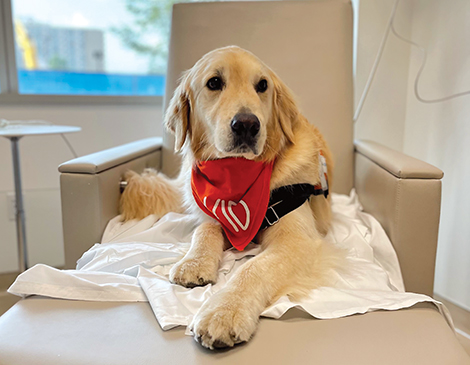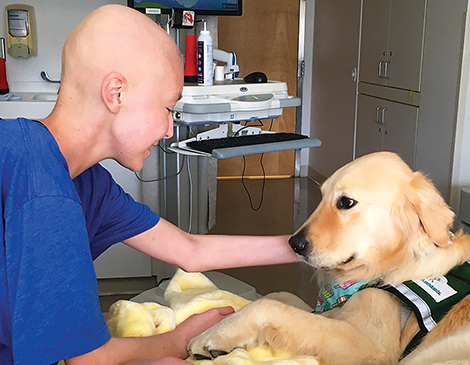Following our recent reporting and print publication, we have been informed that Kid’s cancer returned, and he passed away November 22, 2024. Throughout his years of service Kid brought joy and comfort to all of those around him. We offer our deepest condolences, and for those who would like to share their memories of Kid, his Instagram handle is @pawsincle.
At Cleveland Clinic Children’s Pediatric Outpatient Center, youngsters file in for treatment accompanied by their parents. One boy grumbles distantly about his appetite, while a toddler cozies up to watch Bluey in the waiting area. Down the hall, Kid, a pediatric facility dog, prepares for his day.
Relaxing beneath the desk of his handler, child life specialist Molly Gross, the 6-year-old golden retriever jumps at the chance to meet any friendly face or petting hand. Kid glides down the hallway to his first child of the day, a 10-year-old leukemia patient awaiting three rounds of chemotherapy.
The small girl lifts her head only for Kid as he enters, sniffing around the floor. “Kid, where are my kisses?” she says in a tired voice. Methodically, the dog lifts his front paws to her infusion chair so that she doesn’t have to strain when she reaches out her hand to touch his soft, yellow fur.
She and Kid have more in common than meets the eye. In April, Kid was diagnosed with B-cell lymphoma. “I expected it maybe down the line,” says Gross. “I was surprised that it happened so early.”
Golden retrievers as a breed are at high risk for cancer, especially in old age. B-cell lymphoma is the most common type of lymphoma seen in dogs. Kid would undergo 16 rounds of chemotherapy over 20 weeks.
“As a handler, it was very bizarre,” Gross says. “Suddenly, I was on the other side of the treatment process.”

Kid’s oncology team at MedVet Akron helped him through four treatments. He received four rounds of chemo via IV infusion or orally each cycle, then he would get a week off. Gross was surprised by the similarity of cancer treatments between dogs and people. “He was very familiar with the process.”
Kid is part of a duo from Canine Assistants, an organization based in Alpharetta, Georgia. His partner, Trotter, works with Pediatric Inpatient Units. Facility dogs differ from therapy dogs. As facility dogs, Kid and Trotter are bred and trained for service work. Meanwhile, a therapy dog is a pet who has been trained and certified to provide emotional support. Kid and Trotter clock in each day like the staff, Gross jokes.
Kid lives with Gross, who accompanies him to oncology appointments. She says he reacted to chemo in a similar way to humans, often nauseous and fatigued. “Zofran was our best friend, with him.”
The child life specialists and other staff were careful when and if to break the news about Kid’s diagnosis to their young patients.
“I would always ask the parents first,” Gross says, “and for the most part, they have been open and wanted us to share the news.”
Kid’s role in the hospital helps to create a sense of normalcy for the patients receiving treatment. With him fighting the same disease, it only strengthened his connection with the children he visits. Gross says the patients were interested in Kid’s treatment plan and drew a common thread between his
struggles and theirs.
Kid is now cancer-free. “We had our first checkup for this month, and he had a good checkup,” says Gross. “He will go monthly for labs and a physical exam; that will be our routine for several months.”
Kid’s diagnosis and treatment mirrors what many of the children at Cleveland Clinic are going through. He reflects them in his patchy fur from chemotherapy and the bruise on his left leg from IV infusions — but, most importantly, in his resiliency.
For more updates about Cleveland, sign up for our Cleveland Magazine Daily newsletter, delivered to your inbox six times a week.
For more updates about Cleveland, sign up for our Cleveland Magazine Daily newsletter, delivered to your inbox six times a week.
Cleveland Magazine is also available in print, publishing 12 times a year with immersive features, helpful guides and beautiful photography and design.




